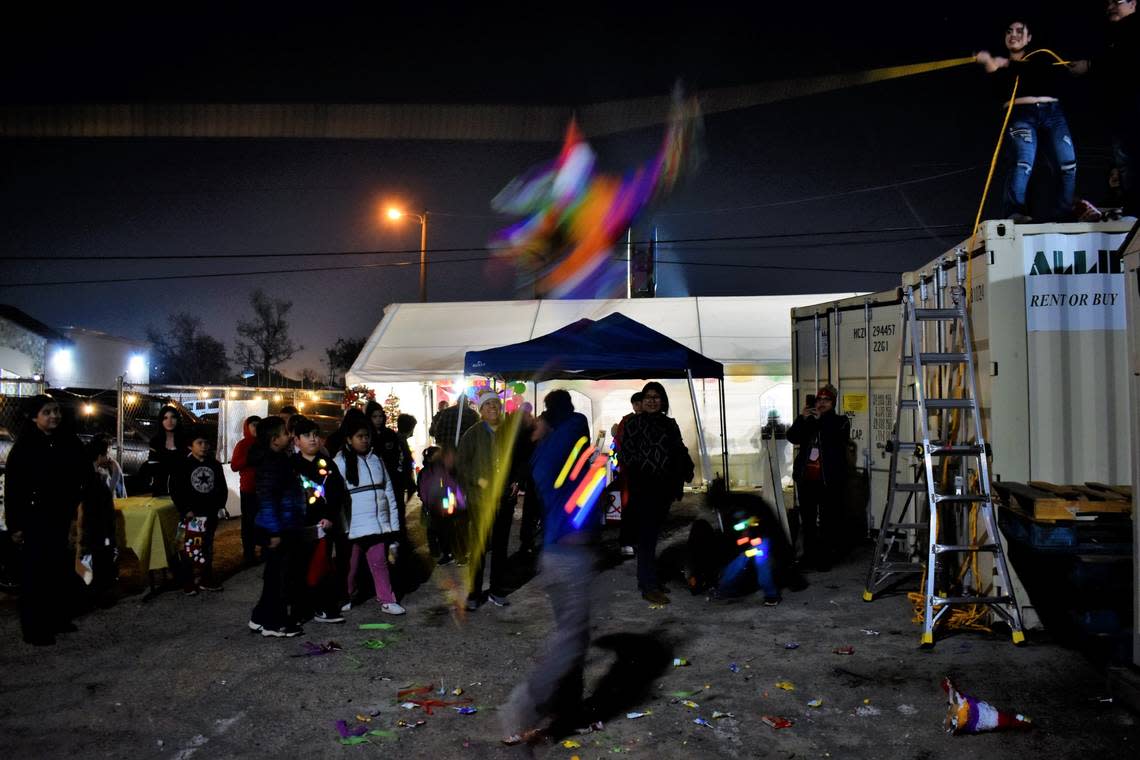Día de la Virgen de Guadalupe holiday marathon underway in Fresno! What to know
For some, Thanksgiving marks the start of the holiday season. For others, the Día de la Virgen de Guadalupe marks the start of a holiday marathon.
Mexican festivities commence every Dec. 12 when Catholic congregations and devotees reverence La Virgen de Guadalupe, the patron saint of Mexico, and continue for three weeks after.
Christmas Eve and Day are celebrated on Dec. 24 and 25 and before New Year’s there’s the Día de los Santos Inocentes, or Day of the Holy Innocents on Dec. 28. Once the new year begins, Jan. 1 is a public holiday and soon after families are gathering again to celebrate Día de Reyes, Three Kings Day, on Jan. 6.
You can see the telling signs the three-week marathon has begun around panaderías, bakeries, and grocery stores where La Virgen de Guadalupe merchandise overflows from shelves and the smell of warm tamales and fresh Rosca de Reyes permeates the air.
“What’s important about the fiestas is to share with our children and teach them about our traditions,” said Margarita Carrera, who has lived in Calwa for 30 years. She moved with her family to Fresno County from the city of Córdoba in the Mexican state of Veracruz when she was 16.
Though these festivities might not be celebrated community-wide in California as they mostly are throughout Mexico, anyone can participate.
La Abeja, a newsletter written for and by California Latinos
Sign up here to receive our weekly newsletter centered around Latino issues in California.
How the ‘marathon’ became tradition
What began as Catholic Mexican celebrations during the Spanish colony years in Latin America, the Guadalupe-Reyes marathon is now also a popular cultural unifier for Mexicans across the world.
Food and community gatherings are traditional parts of the season.
Usually called posadas, translating to hostels or inns in English, Mexican holiday parties acquired that name because the community gathered to sing carols and re-enact the scene of the Virgin Mary and Joseph searching for a place to stay where Mary could give birth.
And while religious traditions remain an important part of the season, not all posadas are religious or involve singing Christmas carols. They’ve become more cultural than religious in some communities, and everyone is welcome to join.
Just like Carrera experienced as a kid in Mexico, Friends of Calwa community organizer Milena Álvarez wanted to recreate the posada experience for the kids in her community last Friday.

“The community, most of it is made up by the Latino population and (is) low income,” Álvarez said. “So, I really thought it would be a good opportunity to get them in touch with the posadas and their Mexican roots.”
She was the person in charge of creating one of the most powerful memories for Mexican kids: swinging the piñata from a high surface and making it rain candy.
“It feels great to be the uncle,” Álvarez said of the duty usually assigned to young men in a family. “I enjoyed how the kids were able to get the candy and experience what usually little kids in Mexico get to experience every year around Christmas time.”
If attending a posada this holiday season, some of the things you might find are:
Piñatas – Though made into many shapes, characters and sizes, piñatas traditionally are a seven-spike star, each representing a cardinal sin. The breaking of the piñata – defeating the sins – is then rewarded with sweets and treats.
Tamales – They can either be sweet or savory, tamales are a must at posadas. Tamales are usually stuffed with pork, beef, chicken in different salsas like mole, red and green. Meatless versions include corn, rajas (pronounced ra-has, green peppers or chiles), beans or cheese. Sweet ones can be chocolate, sugar, sweet corn, and sometimes fruit or cajeta ( pronounced ca-he-ta, caramel similar to dulce de leche).
Candy – More than dessert and something to snack on, candy fills piñatas these days. They represent the riches one gets after not falling into or behaving through a sin… and you also can get them if you show up for the posada.
Champurrado and Mexican hot chocolate – Think of a lightly spiced hot chocolate: some cinnamon and vanilla with a nutty aftertaste. Champurrado is thicker: with some diluted masa (corn flour), piloncillo and sometimes anise, it’s a denser beverage.
Pozole, menudo and chileatole – Soups! More like stews, really. When saying these dishes, all vowels are pronounced: poh-zol-leh, meh-noo-doh, chill-eh-ah-toh-leh. Usually made from beef or pork, these rich caldos will keep you warm during the posada.
Rosca de Reyes – The large, oval-donut-looking sweet bread is decorated with crystallized fruit that symbolizes the jewels on the Three Kings’ crowns. Though it has religious origins – and a baby figurine hidden in the bread itself representing Jesus – it’s become a cultural staple of the season. It pairs great with coffee, hot chocolate or champurrado… and whoever finds the baby figurine in their piece, they are in charge of supplying the tamales for the Día de la Candelaria reunion on Feb. 2.
How you can join the celebration
Be on the lookout for social media posts from organizations, community centers, churches, local businesses, food trucks’ pages and neighbors! Details about posadas are usually shared online or among communities.
See tamales at your grocery store? Or Rosca de Reyes? Give them a try; having a tasting meal with your loved ones is part of the fun.
“I invite you to share with people,” Carrera said. “That’s what’s beautiful about coexisting and teaching kids about what the fiestas are, about traditions.”
“Regardless if you are Catholic, if you practice a different religion or don’t practice at all,” Carrera said, “we invite you to have a meal with us.”






